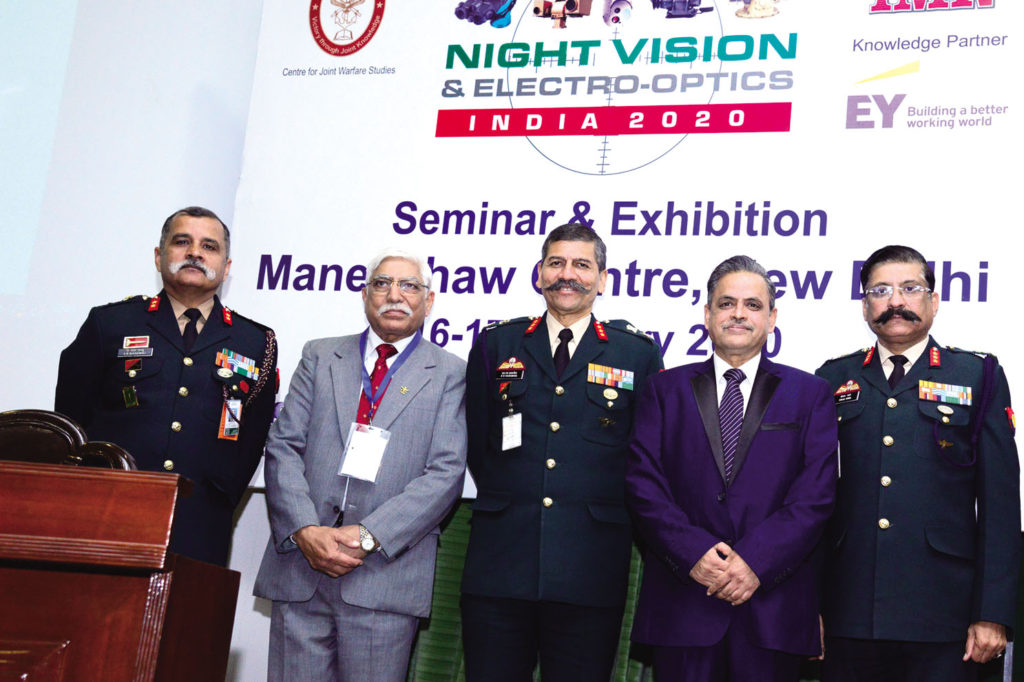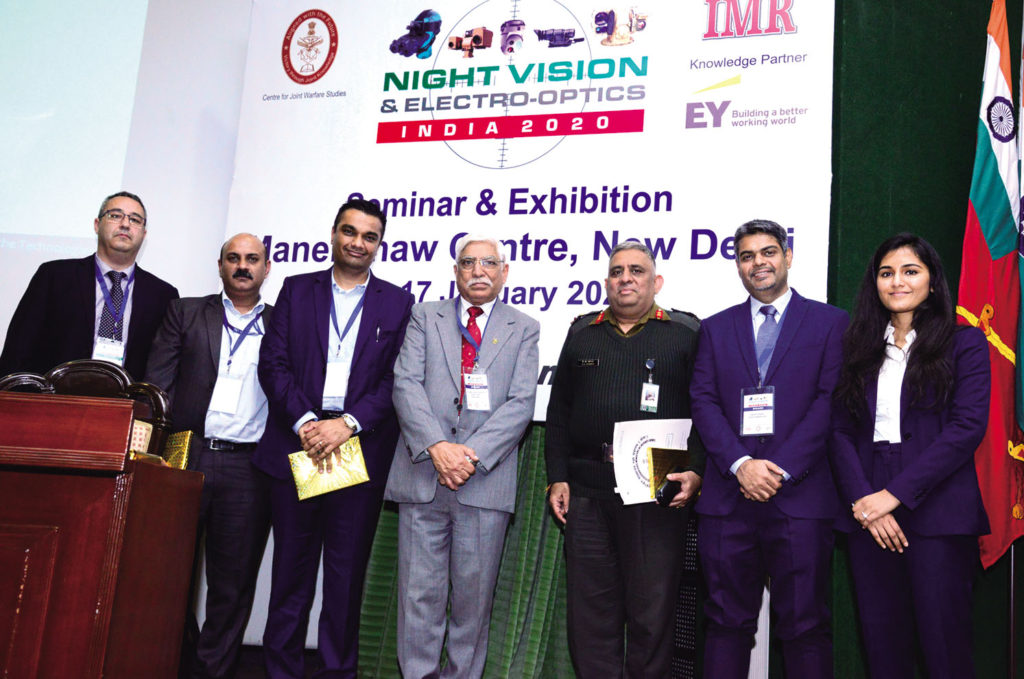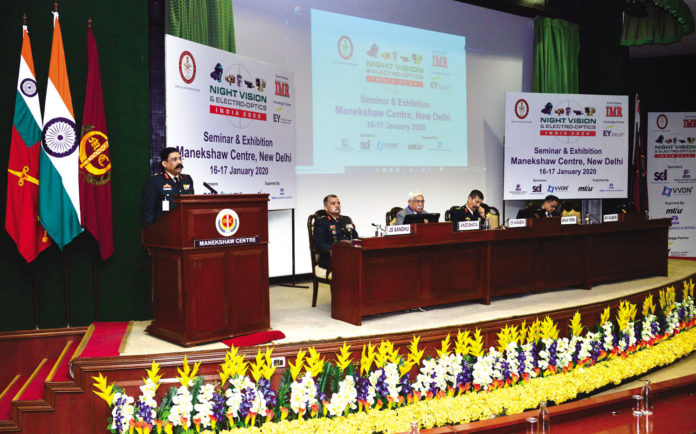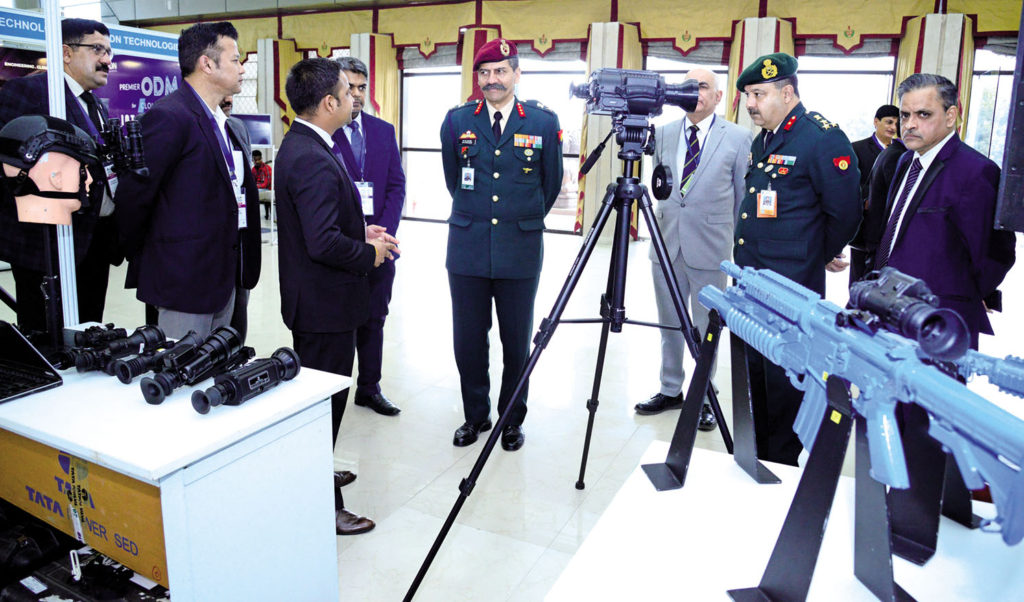Night Vision & Electro-optics India 2020 seminar & exhibition was organised by the Centre for Joint Warfare Studies (CENJOWS) and Indian Military Review on 16-17 January 2020 at New Delhi.
Inaugural Session
Welcome Address. Welcoming the delegates, Lt Gen Vinod Bhatia, Director CENJOWS, averred that interaction with troops on the frontline had revealed that night vision devices (NVD) were lacking both in quantity and contemporary quality. China on the other hand, has invested heavily in high technology equipment, including NVDs. India has to urgently increase its night vision surveillance capabilities to ensure optimum security of its borders. Despite the scaling of NVDs for the Indian Army being finalized, the shortfall of large number of NVDs still existed. He hoped that the Indian armed forces would get the required night vision capabilities at the earliest for effective defence of land borders, air space and long coastline, as also to undertake operational offensive operations in all three domains.
Inaugural Address. Lt Gen SS Hasabnis, DEputy Chief of Army Staff (P&S), Army HQ, said that the Indian Army had to be prepared for conventional, multi-domain and hybrid warfare. The Indian Armed Forces have to follow a threat-cum-capability approach when equipping themselves to deal with such warfare. The counter-insurgency/counter-terrorist (CI/CT) operations and Line of Control (LoC) monitoring requires 24×7 effort. Thus, NVDs can make such operations effective during nighttime as well as during bad weather conditions. He also highlighted that surveillance of the battlefield was a tactical level issue till a few decades back. However, it has now moved to the operational level. Also, war fighting has largely shifted to non-conventional operations and this necessitated a modification in surveillance philosophy. We now need to equip soldiers with night vision from sub-tactical level to operational and strategic levels.

Keynote Address. Lt Gen Sanjay Verma, Director General Weapons & Equipment, Army HQ brought out that the technology changes in NVDs had moved very fast. The Army soldiers and Air Force pilots now want latest Generation-3 NVDs. However, there was a gap between perception of industry and the actual requirements of the armed forces, as far as NVDs were concerned. He mentioned that while the Image Intensifier devices (IIDs) progressed from Generation 0 to Generation 3 in 70 years, the Thermal Imaging (TI) devices had changed the dynamics completely. In 2019-20, the Armed Forces were looking for fusion of II and TI techniques into a single device, as also its integration with the weapon so as to exploit the strengths of both technologies in operations. He also exhorted the industry to try and integrate Artificial Intelligence (AI) into II/TI fused devices; and may be go a step further and provide an underlay of digital maps and global positioning system (GPS) feed into such devices.
Theme Address. Maj Gen JS Sandhu, Additional DG Infantry, Army HQ, emphasized that the weapon in the field was as good as the night sight on it. Thus, the critical requirements for NVDs were weapon compatible ranges, ruggedness, easy sustainability and adequate power requirements. The biggest challenge for the soldier was carriage of multiple power banks at remote posts or during patrolling. A common power bank/charging system would greatly help in reducing the load on the soldier especially for special operations. Moreover, NVDs should be able to withstand vagaries of weather, have in-built GPS and laser range finder (LRF), and be easily portable and maintainable. He said that the Infantry arm intends to upgrade the procurement of II and TI sights for small arms and sniper rifles in batches, to ensure timely upgrades with evolution of technology. He also exhorted the industry to interact and engage freely with the procurers so as to clearly understand the user requirements and explain their products comprehensively.
Session 1–Emerging Technologies
Maj Gen AK Channan, Additional DG Perspective Planning & Head Army Design Bureau, chaired the session and explained the importance of having superior NVDs in operational conditions. He said that the there had been a paradigm shift in the surveillance techniques at the sub-conventional level and in border guarding role. In such a situation, efforts must be made to shorten the sensor-to-shooter loop. Also, the next level of technology should aim at the convergence/fusion of all images into a single networked equipment so that commanders are able to get a comprehensive picture of their area of interest. He invited the representatives from the industry to present their products and technologies and stressed that future NVDs also must cater for measures to guard against counter-NVD devices.
Ronen Sharashov from Semi-conductor Devices, Israel spoke on “Infrared Detectors for Defence Applications.” He gave a detailed presentation on the role and significance of using Infra-Red (IR) detectors for airborne, maritime, land and space applications. He explained the extensive range of cooled and uncooled detectors based on a variety of sensing materials across the entire IR spectrum, viz, NIR, SWIR, MWIR and LWIR.
Bhanu Pratap of VVDN Technologies spoke on “Design Manufacturing in Technology Innovation.” VVDN has end-to-end product development capabilities with special refernce to thermal imaging equipment, which includes PCB and Firmware Development, Mechanical Design, Camera Testing, Compliance with State of the art Infrastructure, Video Management System. All cameras are designed, developed and manufactured in India by VVDN with Source Code availability. VVDN has the capability to customize specifications as per requirements. VVDN Technologies utilises AI, machine learning, big-data analytics technologies to produce innovative solutions to complex problems related to national security and defence. VVDN has a global footprint with nine design and delivery centres, four manufacturing facilites and six global sales offices.
Munjal Shah of Paras Defence made a presentation on use of advanced technologies to produce high quality optical products which are the main components of all MVDs. He said that his company had five vertical to offer products and solutions – Defence & Space Optics, Defence Electronics, Heavy Engineering, EMP Solutions and Niche Technologies. In the Defence & Space verticals, their products included IR lenses, optical domes, difractive gratings, multi-fold lenses, large size space mirrors and metal reflectors & mirrors. Munjal Shah explained the exceptional optical performance of coated Germanium lenses of various thicknesses. Theirs was India’s only company manufacturing Diffractive Gratings for Space Hyperspectral Imaging System, ZnS Domes & Windows, Saphire Domes and Gyro Blocks & Coated Resonator Shells. Their latest offering was precision zoom lenses.
Prachi Gupta of MKU Ltd spoke on “Night Vision – The Benefits of Indigenisation.” She explained the higher costs of imports vis a vis benefits of indigenization which allows for customisation, control over quality and after sales service. She recounted MKU’s business activities and strengths in soldier systems. MKU had Class 10,000 clean rooms and used latest Gen-3 technologies. MKU has supplied equipment to over 230 forces worldwide. It has expertise in optics, electronics and product design for II weapon sights, monoculars and binoculars. She explained the features of Netro NV3000, TW4000, TW4100, NC3000 and TM4100 II sights for various weapons, helmet-mounted binoculars, monoculars and so on.
Vinod Yadav of Tata Power SED, speaking on “Technologies and solutions in EO Domain,” gave an expose on the technologies and solutions in the electro-optical domain.
Session 2–NVD Requirements
Air Marshal Anil Chopra, former Head of Flight Test Centre (ASTE), chaired the session and explained that the first requirement was that the soldier must be equipped properly and be able to see the battlefield clearly. Secondly, he should be able to communicate the battlefield picture upwards to his commanders. He, thereafter, asked the officers from the three Services to spell out their requirements for NVDs keeping these imperatives in mind.
Col Amitoz Singh, Colonel Infantry-8, Directorate General of Infantry, Army HQ, spoke on Infantry Requirements. He explained the scales of all types of NVDs and weapon sights, the quantities for which procurement action had been initiated and the technical requirements of each. He spoke of clip-on type II and TI sights for carbine and assault rifles. He laid out a time line of one and half to two years for procurement of first batch of NVDs, followed by staggered purchases of small quantities, but more frequently.
Col Surya Prakash, Colonel Artillery-9, Directorate General of Artillery, Army HQ, spoke on Artillery’s Requirements. He stressed that LORROS had been the bedrock of surveillance, fall of shot correction and recording at the LoC. He wished that the TI devices had foliage penetration capability and recommended that the industry look at combining the electro-optics and radars for comprehensive all weather, uninterrupted surveillance.
Gp Capt AK Wahi, Group Captain Operations (Space), Air HQ, spoke on Air Force requirements. He explained the peculiarities of the airborne medium, citing that there was a huge problem of too many light sources, as opposed to their absence in the ground environments. He said that NV goggles had huge limitations in fog, mist and smoke, which could have disastrous consequences in the airborne operations, but the pilots could land in total darkness using FLIR. He recommended panoramic (110 degrees) coverage for NVGs, runway and cockpit modifications to suit both, IR and visual modes and better cameras for IR on aircraft.
Capt (IN) Robin Chakravorty, Captain SR (Gun), Directorate of Staff Requirements, Naval HQ, spoke on Indian Navy’s Requirements. He explained the NVDs required for naval ships, aircraft and Special Forces. He stressed on the imperative of all-round field of vision for NVDs, along with stability in roll, pitch and yaw axes for naval platforms. Further, the NVDs must be able to function in multi-spectral domain, to cater for all conditions.
Session 3–Challenges In Combat Operations
Maj Gen (Dr) GD Bakshi, chaired the session and emphasized that the night and all weather fighting ability would be the most critical component of revolution in military affairs (RMA) in future battles. Highlighting the necessity of having NVDs of mixed/different ranges to meet the requirement of varying terrain like high altitude, jungle, riverine or deserts having their own peculiarities, he asked the officers from the Army and central armed police forces (CAPFs) to bring forth the challenges faced in their domains during combat operations.
Col Gurpreet Singh, Colonel Future Ready Combat Vehicle (FRCV), Directorate General of Mechanised Forces, spoke on “Mechanised Forces in Night Operations.” He briefed the audience about battlefield environment and various conflict scenarios which were ever evolving with varying factors of space, probability and high visibility. He highlighted the night enablement and timely connectivity at night as core issues for mechanised forces’ operations.
Brig AN Kukreti, Brigadier Infantry B, Infantry Directorate, Army HQ, spoke on “Enhancing Infantry Operations by Night.” He emphasized the requirement of NVDs for foot soldiers in terms of improved detection, recognition, identification, day & night continuous capability, integration, maintenance & sustenance, reduction in size, weight, cost and power consumption and, lastly, ease of operations. He recommended that future night sights should be modular, with a common basic structure and add-ons based on requirements, for enabling better flexibility and easy upgrades.
NS Jamwal, Inspector General, Frontier HQ, BSF Jammu, gave a presentation on “Challenges in Border Management at Night.” He comprehensively covered all the borders of India, their peculiarities, challenges in dominating them, the electro-optical gadgets available and problems faced by the BSF.
Session 4–R&D and
Maintenance Support
Lt Gen Anjan Mukherjee, Consultant Ordnance Factory Board former DG Artillery, chaired the session and spelt out that major sustenance issues for NVDs were lack of infrastructure, SMTs/STEs, literature, expertise and spares. There was also a need for adequacy of resources, low sustenance cost and obsolescence management of NVDs. Hence, there was a need to build a relationship with the original equipment manufacturers (OEM) beyond the contract stipulations so that their expertise and assistance was available for sustenance until the equipments were in service.
HK Sharma, Principal Scientific Officer, CQA AVA, Avadi, spoke on Quality Control of Night Vision & Electro-optic Devices. He gave out the classification of NVDs and their components requiring quality checks. He went into details of various parameters – image quality, response, noise, resolution, accuracy, geometric, operational and spectral. He also explained the quality test and their procedures.
Benjamin Lionel, Outstanding Scientist and & Director, Instrument Research & Development Establishment (IRDE) DRDO, spoke on “Latest Developments in Night Vision Devices in India.” He touched upon the design, fabrication, thin film coating and assembly of day and night II and TI optical systems and progress made in dual mode (day & IIR) seekers and Infrared Search & Track Systems.

Sourabh Bhaskar, Works Manager, Ordnance Factory Dehradun (OFD), spoke on “Manufacture of NVDs, sights and EO Equipment.” He explained the facilities available and work being carried out by OFD. OFD was working on latest dual band thermal imaging fusion technology with Low Light Level sensor in consultation with IIT. OFD was also working on manufacturing of 12.7 mm SRCG (Stabilized Remote Controlled Gun) for the Indian Navy through transfer of technology and development of LIGHTS (Laser Illuminated Guidance & Homing Targeting system) and CAMOPS (Compact Airborne Multi Sensor Optic Payload System) Project.
Maj Gen SS Suhag, Additional DG EME, Army HQ, spoke on “Sustainment challenges in Electro-optics equipment.” He said that since India’s private industry was progressively becoming technically advanced, especially in the field of NVDs, there was a need for the industry to set up forward repair bases at major Army locations. He felt that annual maintenance contracts (AMCs) based on component replacement approach, particularly for foreign sourced items, were a major drain on Army’s revenue budget. He, therefore, proposed to build in-house repair facilities, particularly for card and ICBs with active collaboration of Indian private players, so as to break the monopoly of foreign propriety vendors.
Valedictory Session
Valedictory Address. Lt Gen Vinod Bhatia, Director CENJOWS pointed out that after scaling, the requirement of NVDs for Infantry alone was above 4 lakhs. Thus overall requirement for the three Services was not only huge, but massive. In addition, the BSF patrolling the 4096 km long border with Bangladesh required large numbers of NVDs for better border management. He felt that the formulation of GSQRs/PSQRs must be prepared by consensus of all stake holders, with due inputs and technological advice of industry. Towards this, he reiterated that CENJOWS had a mandate to bring the industry and users on the same platform and exhorted the industry to use CENJOWS as the via-media for interacting and sending suggestions to relevant users and policy makers in the Government.
Vote of Thanks. Maj Gen Ravi Arora, Chief Editor IMR and Seminar Coordinator, concluded the seminar by thanking the participants and sponsors of the event.



















